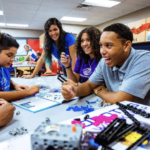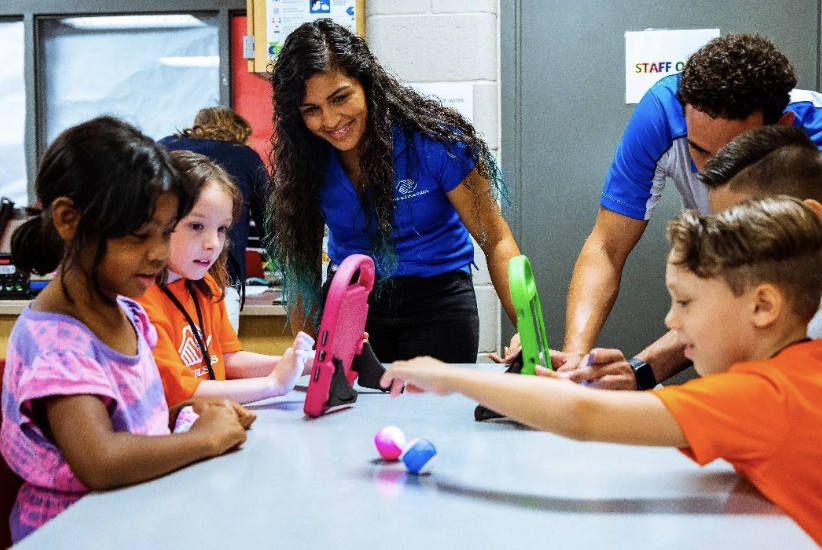Subscribe now to SmartBrief’s FREE email newsletter on Special Education. It’s among SmartBrief’s more than 250 industry-focused newsletters.
________________________
Social-emotional learning helps develop self-awareness, self-control and interpersonal skills that are vital for school, work and overall life success. As a social-emotional learning expert, senior director of counseling and training with Boys & Girls Clubs of the Fox Valley in Wisconsin and a mom of three, I’ve witnessed first-hand the positive outcomes of implementing SEL with kids of all ages. The practice supports identity development; emotion identification and expression that promote regulation; and healthy relationship-building for creating support networks.

When implemented correctly, SEL can have a significant effect on a student’s academic success, lifestyle and character — especially those with special needs. To reap the full benefits of SEL, it’s important to teach it both in and outside of school, as it can reduce the stress on educators in the classroom when used more widely. In working with educators and after-school staff throughout my career, I’m sharing my top three insights on how educators and after-school programs can support each other more seamlessly.
1. Enlist parents and caregivers
We know parents, guardians and caregivers are the experts on their family and their child(ren). Fostering a mutual collaboration with parents/caregivers creates a strong support network around the child. The more we know about a child — what inspires them, what motivates them, what brings them joy, what triggers them, what comforts them, what challenges them — the more we can show up as an active partner in their support system.
A very tangible action educators can implement is obtaining a signed Release of Information that allows educators and school counselors to communicate with staff at after-school programs. This tip is especially helpful for special education teachers who are looking to track the progress of their students.
Every congressional district has a Boys & Girls Club. Classroom teachers who communicate with the after-school programs can learn how youth development is progressing after school. Parents/caregivers also have the power to invite after-school professionals to be part of school-related meetings involving their child’s education, such as conferences or Individualized Education Plans to further bridge goals and strategies between school and after-school programs.
2. Coordinate with after-school programs to ensure a consistency

Social-emotional learning is critical human development that serves us in school, out of school and throughout life. Teaching responsible decision-making contributes to motivation and skill acquisition, helping students learn, lead and live an engaged and healthy life. However, all of the educators and caregivers in a child’s life working together to implement SEL properly promotes the optimal development and outcomes.
Local clubs are empowered and encouraged to partner with local schools to create consistency and predictability of approaches, including but not limited to: CHAMPs classroom management; Positive Behavioral Interventions and Supports; the Developmental Assets framework; the Zones of Regulation cognitive-behavioral approach; and Sources of Strength curriculum. A consistent approach from the school day to out-of-school time can be so powerful..
3. Understand each after-school program’s structure and approach to homework help
After-school programs often implement a constructive youth development model to drive positive outcomes centered around academic success, a healthy lifestyle, and character and leadership skills. This model is made possible with:
- Youth-centered programming. This provides emotional safety, along with a physical and structural environment that are developmentally appropriate and supportive of peer-to-peer and adult-to-youth interactions.
- Positive youth development practices. After-school centers should offer a balance of programs, activities and experiences that address youths’ needs and interests. They should have diverse group sizes and instructional approaches.
- Safe, supportive environments. The center should have sustained, relationship-centered practices that recognize and enhance young people’s strengths and skills.
Integral to the model is recognizing and prioritizing a healthy sense of self, wholesome relationship and emotional regulation.
After-school programming is key to creating a strong, safe foundation to drive a high-quality experience inclusive of social-emotional and subject-specific skill-building outside of school. Teaching responsible decision-making is what contributes to motivation and skill acquisition to learn, lead and live an engaged and healthy life. It’s important that educators and after-school professionals work together to ensure that youth are reaching their full potential.
Carlyn Andrew is a social-emotional learning expert and senior director of counseling and training with Boys & Girls Clubs of the Fox Valley(in northeastern Wisconsin. With nearly 20 years of experience, Carlyn, a parent herself, specializes in trauma-informed practices. Connect with her on LinkedIn, Instagram, Twitter or Facebook.
________________________________
Subscribe now to SmartBrief’s FREE email newsletter on Special Education. It’s among SmartBrief’s more than 250 industry-focused newsletters.
More from SmartBrief Education:
- 5 ways new school-home communication meets family, staff needs
- 5 virtual-classroom tools to foster authentic connections
- Changing the classroom experience with instructional audio
- Powerful social media solutions for students
- How comics curriculum boosts SEL
- 8 ways to make vocabulary instruction more effective
